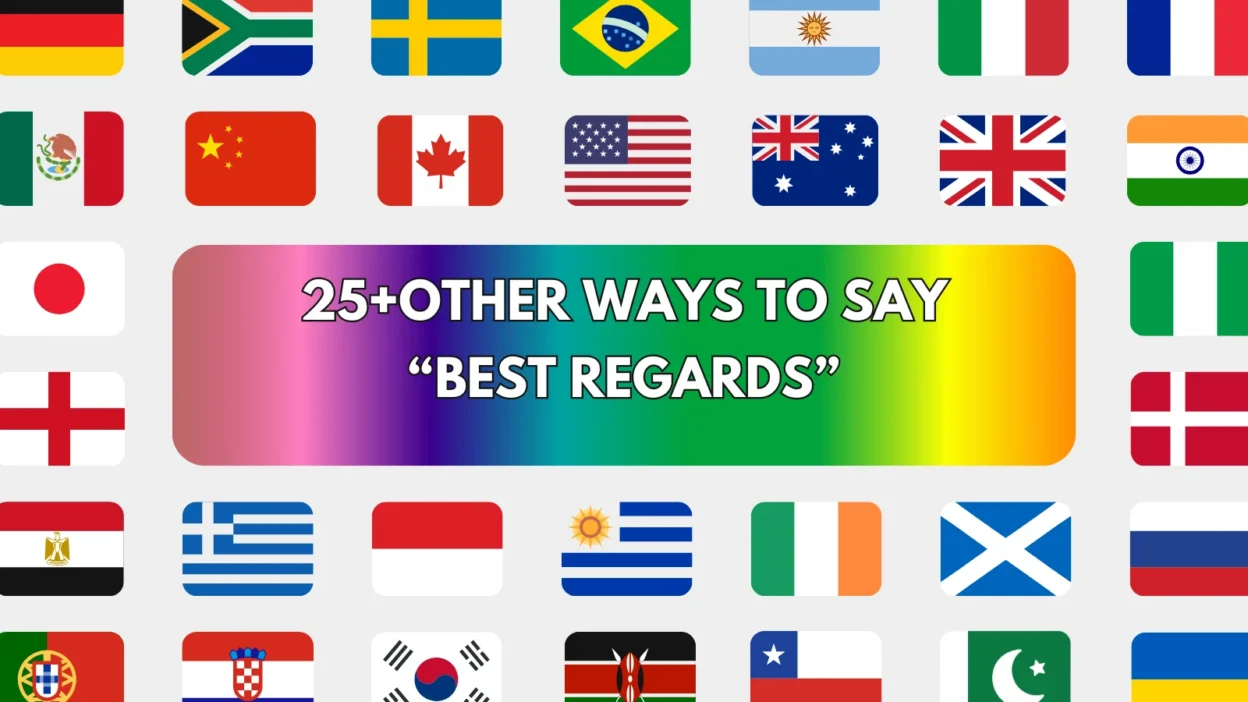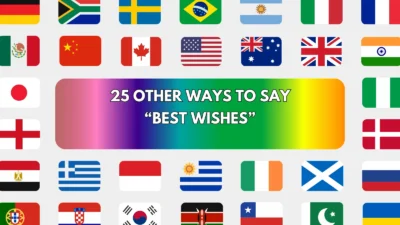The phrase “Best regards” is a classic email and letter sign-off that expresses professionalism and courtesy. It’s polite and safe — which is why it’s used so often. But when you want to personalize your message or match your tone to the situation, it helps to have other phrases on hand.
Whether you’re writing a formal business email, a casual message to a colleague, or a heartfelt note to a client, this article shares 25 alternative ways to say “Best regards”, with clear explanations and examples so you always leave the right impression.
1. Kind regards
Meaning:
A warm and professional closing.
Detailed Explanation:
Slightly softer than “Best regards,” this is perfect for professional settings with a friendly touch.
Scenario Example:
Thank you for your time today. Kind regards,
Anna
Best Use:
Business emails, professional contacts.
Tone:
Polite, warm.
2. Warm regards
Meaning:
A friendlier and more personal closing.
Detailed Explanation:
Great when you want to add a little warmth without being too casual.
Scenario Example:
Looking forward to your response. Warm regards,
James
Best Use:
Client communication, friendly professional tone.
Tone:
Warm, approachable.
3. Sincerely
Meaning:
A traditional and respectful sign-off.
Detailed Explanation:
One of the most formal closings, ideal for official letters and formal documents.
Scenario Example:
Please let me know if you have any concerns. Sincerely,
Dr. Martin
Best Use:
Formal letters, cover letters, official correspondence.
Tone:
Professional, serious.
4. Respectfully
Meaning:
A sign-off that shows respect or deference.
Detailed Explanation:
Often used when writing to someone of higher rank or to express seriousness.
Scenario Example:
Thank you for your attention to this matter. Respectfully,
Lt. Johnson
Best Use:
Formal, hierarchical settings.
Tone:
Formal, respectful.
5. With appreciation
Meaning:
A polite way to express gratitude at the end of a message.
Detailed Explanation:
Suits emails where you’re thanking someone or showing recognition.
Scenario Example:
Thanks again for your support. With appreciation,
Olivia
Best Use:
Thank-you emails, client notes.
Tone:
Grateful, warm.
6. Cheers
Meaning:
A casual and friendly sign-off, often used in the UK and Australia.
Detailed Explanation:
Perfect for informal or semi-formal emails, especially with people you know well.
Scenario Example:
Catch up soon! Cheers,
Sam
Best Use:
Friendly workplace communication.
Tone:
Informal, cheerful.
7. Thanks again
Meaning:
A direct way to reinforce appreciation.
Detailed Explanation:
It’s simple and personal, perfect when gratitude is the focus of your message.
Scenario Example:
I appreciate your quick help with this. Thanks again,
Carla
Best Use:
Quick thank-you notes, work emails.
Tone:
Appreciative, light.
8. All the best
Meaning:
A well-wishing closing with a friendly tone.
Detailed Explanation:
Appropriate for both personal and professional use when you want to wish someone well.
Scenario Example:
Hope everything goes smoothly next week. All the best,
Tom
Best Use:
Colleagues, farewells, job changes.
Tone:
Friendly, supportive.
9. Cordially
Meaning:
A polite and formal closing, often used in invitations.
Detailed Explanation:
Sounds dignified and polished — suitable for formal communications.
Scenario Example:
We await your response. Cordially,
The Events Team
Best Use:
Invitations, formal correspondence.
Tone:
Formal, elegant.
10. Yours truly
Meaning:
A formal way to end letters, especially in American English.
Detailed Explanation:
It expresses honesty and respect — a good fit for official documents.
Scenario Example:
Thank you for your consideration. Yours truly,
Michael Lee
Best Use:
Cover letters, official communications.
Tone:
Formal, professional.
11. Faithfully yours
Meaning:
A formal sign-off that shows loyalty or sincerity.
Detailed Explanation:
Traditional in tone and often used when you don’t know the recipient personally.
Scenario Example:
Please do not hesitate to contact me. Faithfully yours,
Janet
Best Use:
Legal or formal documents.
Tone:
Very formal, respectful.
12. Many thanks
Meaning:
Expresses strong appreciation.
Detailed Explanation:
More enthusiastic than just “Thanks” — still professional.
Scenario Example:
Many thanks for your prompt reply.
Daniel
Best Use:
Polite follow-ups, quick replies.
Tone:
Thankful, friendly.
13. Yours respectfully
Meaning:
Adds a formal and respectful tone to the ending.
Detailed Explanation:
Shows you honor the recipient’s status or role.
Scenario Example:
I appreciate your time and guidance. Yours respectfully,
Nadia
Best Use:
Letters to higher authorities or formal reports.
Tone:
Formal, deferential.
14. Looking forward
Meaning:
Indicates anticipation of future communication.
Detailed Explanation:
Pairs well with optimistic messages or upcoming plans.
Scenario Example:
Looking forward to our meeting next week.
Tina
Best Use:
Follow-up messages, meetings.
Tone:
Upbeat, expectant.
15. With gratitude
Meaning:
Emphasizes appreciation in a formal or heartfelt way.
Detailed Explanation:
Conveys sincere thanks, useful in meaningful messages.
Scenario Example:
Thank you for everything you’ve done. With gratitude,
Sofia
Best Use:
Thank-you notes, special acknowledgments.
Tone:
Sincere, heartfelt.
16. Be well
Meaning:
A warm and thoughtful farewell.
Detailed Explanation:
Balances professionalism with a personal touch.
Scenario Example:
Let me know if anything changes. Be well,
Ethan
Best Use:
Wellness-focused messages, informal notes.
Tone:
Caring, casual.
17. Take care
Meaning:
A caring sign-off that expresses concern for the recipient’s well-being.
Detailed Explanation:
Friendly and kind, but still appropriate for professional emails.
Scenario Example:
Thanks for your help today. Take care,
Maria
Best Use:
Friendly emails, health check-ins.
Tone:
Warm, thoughtful.
18. Talk soon
Meaning:
Shows intent to continue the conversation.
Detailed Explanation:
Casual and upbeat, good for ongoing discussions.
Scenario Example:
Let’s finalize the details tomorrow. Talk soon,
Derek
Best Use:
Colleague chats, follow-ups.
Tone:
Casual, friendly.
19. Speak soon
Meaning:
Another casual way to close with future conversation implied.
Detailed Explanation:
Similar to “Talk soon” — more common in spoken or British English.
Scenario Example:
I’ll send you the draft this evening. Speak soon,
Kate
Best Use:
Team messages, friendly tone.
Tone:
Informal, conversational.
20. Thanks and regards
Meaning:
Combines appreciation and a polite farewell.
Detailed Explanation:
A simple, effective sign-off — suitable for formal emails.
Scenario Example:
Attached is the final document. Thanks and regards,
Imran
Best Use:
Professional communication.
Tone:
Polite, concise.
21. Appreciate your time
Meaning:
Grateful and professional ending.
Detailed Explanation:
Highlights respect for someone’s time and effort.
Scenario Example:
Appreciate your time and help today.
Jessica
Best Use:
After meetings, interviews.
Tone:
Professional, grateful.
22. Thanks again for everything
Meaning:
Adds warmth and emphasis to your gratitude.
Detailed Explanation:
Shows continued or deep appreciation.
Scenario Example:
You’ve been incredibly helpful. Thanks again for everything,
Tyler
Best Use:
Longer-term collaborations or help.
Tone:
Appreciative, sincere.
23. Always a pleasure
Meaning:
Reflects enjoyment in working or communicating with the recipient.
Detailed Explanation:
Friendly and confident — implies a good relationship.
Scenario Example:
Looking forward to more success together. Always a pleasure,
Chloe
Best Use:
Client relationships, team members.
Tone:
Warm, confident.
24. Until next time
Meaning:
A farewell that suggests you’ll connect again soon.
Detailed Explanation:
Best when the conversation is ongoing or part of a regular exchange.
Scenario Example:
Thanks for everything today. Until next time,
Neil
Best Use:
Ongoing business or friendly contacts.
Tone:
Positive, forward-looking.
25. With best wishes
Meaning:
A friendly, caring way to sign off.
Detailed Explanation:
Slightly more personal than “Best regards,” while still professional.
Scenario Example:
Hope the launch goes smoothly. With best wishes,
Aisha
Best Use:
Holiday greetings, farewells, supportive notes.
Tone:
Warm, professional.
Conclusion
While “Best regards” is a reliable sign-off, sometimes switching it up can add just the right personal or professional tone to your message. These 25 alternatives give you the freedom to express appreciation, respect, warmth, or friendliness — whatever your message needs.




